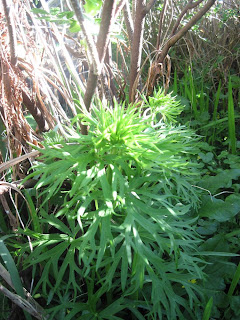While I love the garden at all times of year, there's something extra special about watching plants begin to grow forth in the Spring.
 |
Fritillaria meliagris (Snake's Head Fritillary)
|
The Snake's Head Fritillery, in full flower at the moment, is an endangered species and is the only Fratillary native to this part of the world. It is also an early haunt of bees who are bringing their music to the garden. Maud Grieve noted in her 1931 herbal:
"The bulb is poisonous and very distasteful to the palate and is said to have no medicinal value, though from its presence on the elaborate allegorical frontispiece of the old Herbal of Clusius, Rariorum Plantarum Historia, published in 1601, it bore at that time a reputation as a herb of healing."
|
Alchemilla vulgaris (Lady's Mantle)
A native of Ireland, this herb is a great addition to the herbalist's pharmaceopia. Allen and Hatfield note in "Medicinal Plants in Folk Tradition":
"Rather it is Ireland that seems to have made use of these herbs very largely. The mysterious dew-like appearance of the expressed juice evidently gave them a semi-magical reputation, though they presumably possessed some demonstrable styptic action quite apart from that to have proved popular for cuts and nosebleeds in Derry and , especially, Wicklow, and perhaps a diuretic one too, to have recommended themselves for kidney trouble in Cavan and Kerry."
 |
Ranunculus ficaria (Lesser Celandine)
Celandine grows in abandunce around here and is quite an invasive species, so be careful where you plant it. The herb was often called Pilewort due to it's association as a remedy for haemorrhoids. As Culpeper rather colourfully noted:
"Here is another secret for my countrymean and women, a couple of them together, pilewort made into an oil, ointment or plaster, readily cures both the piles, or haemorrhoids, and the king's evil; the very herb borne about one's body next the skin helps in such diseases, though it never touches the place grieved; let poor people make of it for those uses; with this I cured my own daughter of the king's evil, broke the sore, drew out a quarter pint of corruption, cured without any scar at all in one week's time."
Lovely!
 |
| Artemisia absinthium (Wormwood) |
One of my favourite herbs, the wormwood is also one of our best bitters. As the name might suggest it is also very useful for dealing with parasites, notably Ascaris lumbricoides (roundworm), Enterobius vermicularis (pinworm) and Stronglyoides stercoralis (threadworm). It is a great tonic herb for the digestive tract but let's just say it has an acquired taste! The alcoholic beverage Absinthe, originally a medicinal liquer created by Dr Pierre Ordinaire, is made from Wormwood and gained a reputation among bohemian culture until it was banned in 1915 due to its reported hallucinogenic effects. However it has recently had a revival since the 1990's.
 |
| Aconitum napellus (Wolfsbane) |
CAUTION: Also known as Monkshood, this herb is highly toxic and contains a cardiac posion (aconitine) that was once used on the tips of spears! Gerard, quoting the mighty Avicenna, commented:
"The symptoms that follow those that doe eat these deadly Herbs are these: their lipps and tongue swell forthwith, their eyes hang out, their thighes are stiffe, and their wits are taken from them, as Avicen writes. The force of this poison is such, that if the points of darts or arrowes be tocuhed therewith, it brings deadly hurt to those who are wounded with same." |
As with any herbs mentioned on this site, do not use unless you have consulted a professional herbalist. Correct identification of herbs is also vital! |





No comments:
Post a Comment